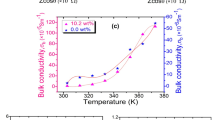Summary
The dielectric relaxations in solution-grown polycarbonate thin films have been studied as a function of poling field (1.0·105÷÷7.0·105) V/m, temperature (310÷400) K, time (3.60·103÷2.88·104) s, film thickness (1÷50) μm, nature of the vacuum-deposited electrode metals, namely silver, aluminium and indium, used during polarization and the different heating rates of depolarization (0.05÷0.17) K/s by the thermally stimulated discharge current technique. Three relaxation processes at 352, 436 and 483 K are observed to have activation energies (0.52±0.02), (0.78±0.02) and (1.45±0.02) eV and relaxation times at 300 K of 4.17·103, 2.61·106 and 3.24·1011 s, respectively. The magnitude of the maximum current corresponding to the peak at 352 K and the charge associated with it increases linearly with the field and it is attributed to the movement of the phenyl group with the molecular motion of the carbonate group of the main chain. The peak at 436 K is attributed to the detrapping of the charge carriers, whereas the peak at 483 K is due to the trapped space charges which are a resultant of the already present carriers and the carriers injected from the electrodes during polarization. The increase in the activation energies associated with peaks at 352 and 436 K and their shift towards higher temperatures with the increase in the poling temperature and time suggest that these peaks have a distribution of relaxation times.
Riassunto
Si sono studiati i rilassamenti dielettrici in sottili film di policarbonati cresciuti in soluzione, in funzione di campi con poli (1.0·105÷7·105) V/m, della temperatura (310÷400) K, del tempo (3.60·103÷2.88·104) s, dello spessore del film (1÷50)μm, della natura dei metalli degli elettrodi depositati sotto vuoto, cioè argento, alluminio e indio, usati durante la polarizzazione, e i diversi tassi di riscaldamento di depolarizzazione (0.05÷0.17) K/s per mezzo della tecnica della corrente di scarica stimolata termicamente. Si osservano tre processi di rilassamento a 352, 436 e 483 K con energie di attivazione (0.52±0.02), (0.78±0.02) e (1.45±0.02) e V e tempi di rilassamento a 300 K di 4.17·103, 2.61·106 e 3.24·1011, rispettivamente. La grandezza della corrente massima che corrisponde al picco a 352 K e la carica associata ad essa aumenta linearmente con il campo ed è attribuita al movimento del radicale fenile col moto molecolare del radicale carbonato della catena principale. Il picco a 436 K è attribuito allo avincolamento dei trasportatori di carica, mentre il picco al 483 K è dovuto alle cariche spaziali intrappolate che sono la risultante dei trasportatori già presenti e dei trasportatori iniettati dagli elettrodi durante la polarizzazione. L’aumento nelle energie di attivazione associate a picchi a 352 e 436 K e i loro spostamenti verso temperature più alte con l’aumento nella temperature e nel tempo di polatura suggeriscono che questi picchi abbiano una distribuzione di tempi di rilassamento.
Similar content being viewed by others
References
P. K. C. Pillai, K. Jain andV. K. Jain:Phys. Status Solidi A,13, 341 (1972);Nuovo Cimento B,3, 225 (1971).
J. Vanderschueren andA. Linkens:J. Polym. Sci. Polymer. Phys. Ed.,16, 223 (1978).
J. Van Tornhout:Thermally Stimulated Discharge of Polymer Electrets (Amsterdam, 1975);Polym. J.,2, 173 (1971).
J. Vanderschueren:J. Polym. Sci. Polym. Phys. Ed.,12, 991 (1974).
P. C. Mehendru, K. Jain andP. Mehendru:J. Phys. D,9, 83 (1976);10, 729 (1977).
N. P. Gupta, K. Jain andP. C. Mehendru:J. Chem. Phys.,68, 1785 (1978).
M. M. Perlman:J. Appl. Phys.,42, 2645 (1971).
O. Yano:J. Polym. Sci. Polym. Phys. Ed.,16, 679 (1978).
Y. Aoki andJ. O. Brittain:J. Appl. Polym. Sci.,20, 2879 (1976);J. Polym. Sci. Polym. Phys. Ed.,14, 1297 (1976);15, 199 (1977).
A. Linkens andJ. Vanderschueren:J. Electrostat.,3, 149 (1977);Polym. Lett.,15, 41 (1977).
A. C. Rastogi andK. L. Chopra:Thin Solid Films,18, 187 (1973).
H. Schnell:Chemistry and Physics of Polycarbonates (New York, N. Y., 1964).
K. Jain, A. C. Rastogi andK. L. Chopra:Phys. Status Solidi A,20, 167 (1973).
P. K. C. Pillai, K. Jain andV. K. Jain:Phys. Lett. A,39, 216 (1972).
G. F. J. Garlick andA. F. Gibson:Proc. Phys. Soc. London,60, 574 (1948).
L. I. Gross-Weiner:J. Appl. Phys.,24, 1306 (1953).
C. Bucci andR. Fieschi:Phys. Rev. Lett.,12, 16 (1966).
W. Hoogenstraten:Philips Res. Rep.,13, 515 (1958).
E. Sacher:J. Macromol. Sci. B,10, 319 (1974).
G. Locati andA. V. Tobolsky:Adv. Mol. Relaxation Processes,1, 375 (1970).
A. K. Johnscher:Thin Solid Films,1, 213 (1967).
P. Fischer andP. Rohl:J. Polym. Sci. Polym. Phys. Ed.,13, 1247 (1975);T. Hino:Jpn. J. Appl. Phys.,12, 611 (1973).
N. P. Gupta, K. Jain andP. C. Mehendru:Thin Solid Films, accepted for publication.
A. L. Renninger, G. G. Wicks andD. R. Ohlmann:J. Polym. Sic. Polym. Phys. Ed.,13, 1247 (1975).
S. Ikeda andK. Matsuda:Jpn. J. Appl. Phys.,15, 963 (1976).
G. Caserta andA. Serra:J. Appl. Phys.,42, 3778 (1971).
H. Geiger andK. Scheel:Handbuch der Physik, Vol.23 (Berlin, 1943).
G. Pfestorf andE. F. Richter:Phys. Z.,39, 141 (1938).
D. K. Davies:Br. J. Appl. Phys.,2, 1533 (1969).
P. C. Mehendru, K. Jain andP. Mehendru:J. Phys. D,11, 1431 (1978).
Author information
Authors and Affiliations
Additional information
To speed up publication, the authors of this paper have agreed to not receive the proofs for correction.
Traduzione a cura della Redazione.
Rights and permissions
About this article
Cite this article
Jain, K., Agrawal, J.P. & Mehendru, P.C. Dielectric relaxations in solution-grown polycarbonate thin films.—I. Nuov Cim B 55, 123–142 (1980). https://doi.org/10.1007/BF02728382
Received:
Published:
Issue Date:
DOI: https://doi.org/10.1007/BF02728382




